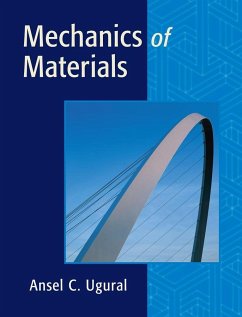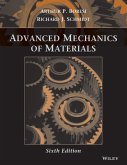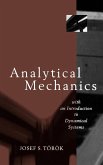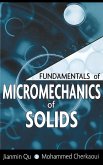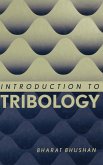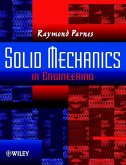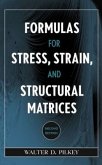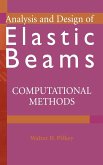Ansel C. Ugural
Mechanics of Materials
Ansel C. Ugural
Mechanics of Materials
- Gebundenes Buch
- Merkliste
- Auf die Merkliste
- Bewerten Bewerten
- Teilen
- Produkt teilen
- Produkterinnerung
- Produkterinnerung
Mechanics of Materials teaches concepts and problem-solving skills with practical applications. The text provides a wide variety of worked examples, case studies, and homework problems to motivate students and help them develop their problem-solving skills. Mechanics of Materials provides a visual, concise, and technically accurate presentation which appeals to today's student.
Ugural provides a comprehensive and methodical presentation of the basic concepts in the analysis of members subjected to axial loads, torsion, bending, and pressure. The material presented strikes a balance between…mehr
Andere Kunden interessierten sich auch für
![Advanced Mechanics of Materials Advanced Mechanics of Materials]() Arthur P. BoresiAdvanced Mechanics of Materials312,99 €
Arthur P. BoresiAdvanced Mechanics of Materials312,99 €![Analytical Mechanics Analytical Mechanics]() Joseph S. TorokAnalytical Mechanics171,99 €
Joseph S. TorokAnalytical Mechanics171,99 €![Fundamentals of Micromechanics of Solids Fundamentals of Micromechanics of Solids]() Jianmin QuFundamentals of Micromechanics of Solids156,99 €
Jianmin QuFundamentals of Micromechanics of Solids156,99 €![Introduction to Tribology Introduction to Tribology]() Bharat BhushanIntroduction to Tribology190,99 €
Bharat BhushanIntroduction to Tribology190,99 €![Solid Mechanics in Engineering Solid Mechanics in Engineering]() Raymond ParnesSolid Mechanics in Engineering97,99 €
Raymond ParnesSolid Mechanics in Engineering97,99 €![Formulas for Stress, Strain, and Structural Matrices Formulas for Stress, Strain, and Structural Matrices]() Walter D. PilkeyFormulas for Stress, Strain, and Structural Matrices250,99 €
Walter D. PilkeyFormulas for Stress, Strain, and Structural Matrices250,99 €![Analysis and Design of Elastic Beams Analysis and Design of Elastic Beams]() Walter D. PilkeyAnalysis and Design of Elastic Beams156,99 €
Walter D. PilkeyAnalysis and Design of Elastic Beams156,99 €-
-
-
Mechanics of Materials teaches concepts and problem-solving skills with practical applications. The text provides a wide variety of worked examples, case studies, and homework problems to motivate students and help them develop their problem-solving skills. Mechanics of Materials provides a visual, concise, and technically accurate presentation which appeals to today's student.
Ugural provides a comprehensive and methodical presentation of the basic concepts in the analysis of members subjected to axial loads, torsion, bending, and pressure. The material presented strikes a balance between the theory necessary to gain insight into mechanics and numerical solutions, both of which are useful in performing stress analysis in a realistic setting. Readers will also benefit from the visual interpretation of the basic equations and of the means by which the loads are resisted in typical members.
Hinweis: Dieser Artikel kann nur an eine deutsche Lieferadresse ausgeliefert werden.
Ugural provides a comprehensive and methodical presentation of the basic concepts in the analysis of members subjected to axial loads, torsion, bending, and pressure. The material presented strikes a balance between the theory necessary to gain insight into mechanics and numerical solutions, both of which are useful in performing stress analysis in a realistic setting. Readers will also benefit from the visual interpretation of the basic equations and of the means by which the loads are resisted in typical members.
Hinweis: Dieser Artikel kann nur an eine deutsche Lieferadresse ausgeliefert werden.
Produktdetails
- Produktdetails
- Verlag: Wiley & Sons
- Artikelnr. des Verlages: 14672115000
- 1. Auflage
- Seitenzahl: 736
- Erscheinungstermin: 26. Februar 2007
- Englisch
- Abmessung: 262mm x 210mm x 34mm
- Gewicht: 1365g
- ISBN-13: 9780471721154
- ISBN-10: 0471721158
- Artikelnr.: 21344597
- Herstellerkennzeichnung
- Libri GmbH
- Europaallee 1
- 36244 Bad Hersfeld
- gpsr@libri.de
- Verlag: Wiley & Sons
- Artikelnr. des Verlages: 14672115000
- 1. Auflage
- Seitenzahl: 736
- Erscheinungstermin: 26. Februar 2007
- Englisch
- Abmessung: 262mm x 210mm x 34mm
- Gewicht: 1365g
- ISBN-13: 9780471721154
- ISBN-10: 0471721158
- Artikelnr.: 21344597
- Herstellerkennzeichnung
- Libri GmbH
- Europaallee 1
- 36244 Bad Hersfeld
- gpsr@libri.de
Ansel C. Ugural, Ph.D., is Research Professor at New Jersey Institute of Technology. He has held various faculty and administrative positions at Fairleigh Dickinson University, and he taught at the University of Wisconsin. Ugural has considerable industrial experience in both full-time and consulting capacities.
PREFACE vii
LIST OF SYMBOLS xix
Chapter 1 INTRODUCTION 1
1.1 Mechanics of Materials 2
1.2 Scope of the Book 3
1.3 Methods of Analysis 4
1.4 Engineering Design 5
1.5 Review of Static Equilibrium 6
1.6 Internal Force Resultants 10
1.7 Problem Formulation and Solution 13
1.8 Application to Simple Structures 15
Chapter Summary 26
References 27
Chapter 2 CONCEPT OF STRESS 28
2.1 Introduction 29
2.2 Internal Axial Forces 29
2.3 Normal Stress 31
2.4 Bearing Stress in Connections 37
2.5 Shearing Stress 38
2.6 Stresses in Simple Structures 43
2.7 Allowable Stress and Factor of Safety 52
2.8 Design of Bars for Axial Loading 56
2.9 Case Studies 60
2.10 Stress under General Loading 68
Chapter Summary 77
References 78
Chapter 3 STRAIN AND MATERIAL PROPERTIES 79
3.1 Introduction 80
3.2 Deformation 80
3.3 Strain 81
3.4 Components of Strain 84
3.5 Materials 89
3.6 Stress-Strain Diagrams 90
3.7 True Stress and True Strain 97
3.8 Elastic versus Plastic Behavior 98
3.9 Hooke's Law 99
3.10 Poisson's Ratio 102
3.11 Generalized Hooke's Law 108
3.12 Strain Energy 113
3.13 Impact Strength 115
3.14 Fatigue 116
3.15 Permanent Deformation 119
3.16 General Properties of Materials 121
3.17 Selecting Materials 122
Chapter Summary 127
References 129
Chapter 4 AXIALLY LOADED MEMBERS 130
4.1 Introduction 131
4.2 Deformation of Axially Loaded Members 131
4.3 Statically Indeterminate Structures 143
4.4 Method of Superposition 147
4.5 Thermal Deformation and Stress 148
4.6 Stresses on Inclined Planes 156
4.7 Saint-Venant's Principle 159
4.8 Stress Concentrations 160
4.9 Ductility and Design 164
4.10 Plastic Deformation and Residual Stress 165
Chapter Summary 172
References 173
Chapter 5 TORSION 174
5.1 Introduction 175
5.2 Deformation of a Circular Shaft 175
5.3 The Torsion Formula 178
5.4 Axial and Transverse Shear Stresses 180
5.5 Stresses on Inclined Planes 183
5.6 Angle of Twist 188
5.7 Statically Indeterminate Shafts 196
5.8 Design of Circular Shafts 202
5.9 Stress Concentrations 206
5.10 Inelastic Torsion of Circular Shafts 211
5.11 Torsion of Noncircular Solid Bars 215
5.12 Thin-Walled Hollow Members 218
Chapter Summary 228
References 230
Chapter 6 SHEAR AND MOMENT IN BEAMS 231
6.1 Introduction 232
6.2 Classification of Beams 232
6.3 Calculation of Beam Reactions 233
6.4 Shear Force and Bending Moment 238
6.5 Load, Shear, and Moment Relationships 243
6.6 Shear and Moment Diagrams 245
6.7 Discontinuity Functions 259
Chapter Summary 268
References 270
Chapter 7 STRESSES IN BEAMS 271
7.1 Introduction 272
PART A Pure Bending 273
7.2 Beam Deformation in Pure Bending 273
7.3 Assumptions of Beam Theory 275
7.4 Normal Strain in Beams 276
7.5 Normal Stress in Beams 280
7.6 Stress Concentrations in Bending 285
PART B Shear and Bending 292
7.7 Shear Stresses in Beams 292
7.8 Shear Stress Distribution in Rectangular Beams 297
7.9 Shear Stresses in Beams of Circular Cross Section 299
7.10 Shear Stress Distribution in Flanged Beams 300
7.11 Comparison of Shear and Bending Stresses 304
7.12 Design of Prismatic Beams 308
7.13 Design of Beams of Constant Strength 311
PART C Special Topics 321
7.14 Composite Beams 321
7.15 Reinforced Concrete Beams 325
7.16 Unsymmetric Bending 327
7.17 Shear Center 332
7.18 Inelastic Bending 334
7.19 Curved Beams 341
Chapter Summary 356
References 359
Chapter 8 TRANSFORMATION OF STRESS AND STRAIN 360
8.1 Introduction 361
8.2 Plane Stress 361
8.3 Principal Stresses 367
8.4 Maximum Shear Stress 368
8.5 Mohr's Circle for Plane Stress 370
8.6 Absolute Maximum Shear Stress 383
8.7 Principal Stresses for a General State of Stress 384
8.8 Thin-Walled Pressure Vessels 385
8.9 Thick-Walled Pressure Vessels 393
8.10 Plane Strain 402
8.11 Mohr's Circle for Plane Strain 405
8.12 Measurement of Strain;Strain Rosette 409
8.13 Relation Involving E, n, and G 412
Chapter Summary 416
References 418
Chapter 9 COMBINED LOADINGS AND FAILURE CRITERIA 419
9.1 Introduction 420
PART A Combined Stresses 421
9.2 Axial and Torsional Loads 421
9.3 Direct Shear and Torsional Loads: Helical Springs 427
9.4 Axial, Transverse, and Torsional Loads 431
9.5 Transverse Shear and Bending MomentLoads: Principal Stresses in Beams
437
9.6 Eccentric Axial Loads 440
PARTB Failure Theories inDesign 450
9.7 Material Failure 450
9.8 Yield Criteria for Ductile Materials 451
9.9 Fracture Criteria for Brittle Materials 454
9.10 Design of Transmission Shafts 460
Chapter Summary 468
References 470
Chapter 10 DEFLECTIONS OF BEAMS 471
10.1 Introduction 472
10.2 The Elastic Curve 472
10.3 Boundary Conditions 473
10.4 Method of Integration 476
10.5 Use of Discontinuity Functions 487
10.6 Method of Superposition 493
10.7 Statically Indeterminate Beams 496
10.8 Statically Indeterminate Beams-Method of Integration 497
10.9 Statically Indeterminate Beams-Method of Superposition 507
10.10 Moment-Area Method 514
10.11 Statically Indeterminate Beams-Moment-Area Method 525
10.12 Continuous Beams 527
Chapter Summary 535
References 536
Chapter 11 BUCKLING OF COLUMNS 537
11.1 Introduction 538
11.2 Stability of Structures 538
11.3 Pin-Ended Columns 540
11.4 Columns with Other End Conditions 542
11.5 Critical Stress: Classification of Columns 547
11.6 Eccentric Loaded Columns and the Secant Formula 558
11.7 Design of Columns for Centric Loading 564
11.8 Design of Columns for Eccentric Loading 569
Chapter Summary 574
References 575
Chapter 12 ENERGY METHODS AND IMPACT 576
12.1 Introduction 577
12.2 Strain Energy under Axial Loading 577
12.3 Strain Energy in Circular Shafts 580
12.4 Strain Energy in Beams 581
12.5 Strain Energy for a General State of Stress 584
12.6 Conservation of Energy 589
12.7 Displacement under a Single Load by the Work-Energy Method 590
12.8 Displacements by Castigliano's Theorem 593
12.9 Unit-Load Method 599
12.10 Statically Indeterminate Structures 602
12.11 Impact Loading 609
12.12 Longitudinal and Bending Impact 610
Chapter Summary 621
References 623
Chapter 13 FINITE ELEMENT ANALYSIS 624
13.1 Introduction 625
13.2 The Bar Element 626
13.3 Two-Dimensional Bar Element 627
13.4 Axial Force in the Bar Element 630
13.5 Formulation of the Finite Element Method 631
13.6 Beam Elements 644
Chapter Summary 652
References 653
Appendix A PROPERTIES OF AREAS 655
A.1 Centroid of an Area 655
A.2 Moments of Inertia and Radius of Gyration 658
A.3 Parallel-Axis Theorem 660
A.4 Principal Moments of Inertia 662
Appendix B TABLES 667
B.1 Principal SI Units Used in Mechanics 668
B.2 SI Prefixes 668
B.3 Conversion Factors between U.S. Customary and SI Units 669
B.4 Properties of Selected Engineering Materials 670
B.5 Materials and Selected Members of Each Class 672
B.6 Properties of Areas 674
B.7 Properties of Selected Steel Pipe and Tubing 675
B.8 Properties of Steel W Shapes, Wide-Flange Sections 676
B.9 Properties of Steel S Shapes, American Standard I-Beams 678
B.10 Properties of Steel C Shapes, American Standard Channels 680
B.11 Properties of Steel L Shapes, Angles with Equal Legs 682
B.12 Properties of Steel L Shapes, Angles with Unequal Legs 684
B.13 Properties of Structural Lumber 686
B.14 Deflections and Slopes of Beams 687
B.15 Reactions and Deflections of Statically Indeterminate Beams 689
Appendix C MATRIX ALGEBRA 690
C.1 Definition of a Matrix 690
C.2 Determinant of a Matrix 691
C.3 Matrix Operations 693
C.4 Simultaneous Linear Equations 695
Appendix D FUNDAMENTALS OF ENGINEERING EXAMINATION 697
ANSWERS TO SELECTED EVEN-NUMBERED PROBLEMS 698
INDEX 711
LIST OF SYMBOLS xix
Chapter 1 INTRODUCTION 1
1.1 Mechanics of Materials 2
1.2 Scope of the Book 3
1.3 Methods of Analysis 4
1.4 Engineering Design 5
1.5 Review of Static Equilibrium 6
1.6 Internal Force Resultants 10
1.7 Problem Formulation and Solution 13
1.8 Application to Simple Structures 15
Chapter Summary 26
References 27
Chapter 2 CONCEPT OF STRESS 28
2.1 Introduction 29
2.2 Internal Axial Forces 29
2.3 Normal Stress 31
2.4 Bearing Stress in Connections 37
2.5 Shearing Stress 38
2.6 Stresses in Simple Structures 43
2.7 Allowable Stress and Factor of Safety 52
2.8 Design of Bars for Axial Loading 56
2.9 Case Studies 60
2.10 Stress under General Loading 68
Chapter Summary 77
References 78
Chapter 3 STRAIN AND MATERIAL PROPERTIES 79
3.1 Introduction 80
3.2 Deformation 80
3.3 Strain 81
3.4 Components of Strain 84
3.5 Materials 89
3.6 Stress-Strain Diagrams 90
3.7 True Stress and True Strain 97
3.8 Elastic versus Plastic Behavior 98
3.9 Hooke's Law 99
3.10 Poisson's Ratio 102
3.11 Generalized Hooke's Law 108
3.12 Strain Energy 113
3.13 Impact Strength 115
3.14 Fatigue 116
3.15 Permanent Deformation 119
3.16 General Properties of Materials 121
3.17 Selecting Materials 122
Chapter Summary 127
References 129
Chapter 4 AXIALLY LOADED MEMBERS 130
4.1 Introduction 131
4.2 Deformation of Axially Loaded Members 131
4.3 Statically Indeterminate Structures 143
4.4 Method of Superposition 147
4.5 Thermal Deformation and Stress 148
4.6 Stresses on Inclined Planes 156
4.7 Saint-Venant's Principle 159
4.8 Stress Concentrations 160
4.9 Ductility and Design 164
4.10 Plastic Deformation and Residual Stress 165
Chapter Summary 172
References 173
Chapter 5 TORSION 174
5.1 Introduction 175
5.2 Deformation of a Circular Shaft 175
5.3 The Torsion Formula 178
5.4 Axial and Transverse Shear Stresses 180
5.5 Stresses on Inclined Planes 183
5.6 Angle of Twist 188
5.7 Statically Indeterminate Shafts 196
5.8 Design of Circular Shafts 202
5.9 Stress Concentrations 206
5.10 Inelastic Torsion of Circular Shafts 211
5.11 Torsion of Noncircular Solid Bars 215
5.12 Thin-Walled Hollow Members 218
Chapter Summary 228
References 230
Chapter 6 SHEAR AND MOMENT IN BEAMS 231
6.1 Introduction 232
6.2 Classification of Beams 232
6.3 Calculation of Beam Reactions 233
6.4 Shear Force and Bending Moment 238
6.5 Load, Shear, and Moment Relationships 243
6.6 Shear and Moment Diagrams 245
6.7 Discontinuity Functions 259
Chapter Summary 268
References 270
Chapter 7 STRESSES IN BEAMS 271
7.1 Introduction 272
PART A Pure Bending 273
7.2 Beam Deformation in Pure Bending 273
7.3 Assumptions of Beam Theory 275
7.4 Normal Strain in Beams 276
7.5 Normal Stress in Beams 280
7.6 Stress Concentrations in Bending 285
PART B Shear and Bending 292
7.7 Shear Stresses in Beams 292
7.8 Shear Stress Distribution in Rectangular Beams 297
7.9 Shear Stresses in Beams of Circular Cross Section 299
7.10 Shear Stress Distribution in Flanged Beams 300
7.11 Comparison of Shear and Bending Stresses 304
7.12 Design of Prismatic Beams 308
7.13 Design of Beams of Constant Strength 311
PART C Special Topics 321
7.14 Composite Beams 321
7.15 Reinforced Concrete Beams 325
7.16 Unsymmetric Bending 327
7.17 Shear Center 332
7.18 Inelastic Bending 334
7.19 Curved Beams 341
Chapter Summary 356
References 359
Chapter 8 TRANSFORMATION OF STRESS AND STRAIN 360
8.1 Introduction 361
8.2 Plane Stress 361
8.3 Principal Stresses 367
8.4 Maximum Shear Stress 368
8.5 Mohr's Circle for Plane Stress 370
8.6 Absolute Maximum Shear Stress 383
8.7 Principal Stresses for a General State of Stress 384
8.8 Thin-Walled Pressure Vessels 385
8.9 Thick-Walled Pressure Vessels 393
8.10 Plane Strain 402
8.11 Mohr's Circle for Plane Strain 405
8.12 Measurement of Strain;Strain Rosette 409
8.13 Relation Involving E, n, and G 412
Chapter Summary 416
References 418
Chapter 9 COMBINED LOADINGS AND FAILURE CRITERIA 419
9.1 Introduction 420
PART A Combined Stresses 421
9.2 Axial and Torsional Loads 421
9.3 Direct Shear and Torsional Loads: Helical Springs 427
9.4 Axial, Transverse, and Torsional Loads 431
9.5 Transverse Shear and Bending MomentLoads: Principal Stresses in Beams
437
9.6 Eccentric Axial Loads 440
PARTB Failure Theories inDesign 450
9.7 Material Failure 450
9.8 Yield Criteria for Ductile Materials 451
9.9 Fracture Criteria for Brittle Materials 454
9.10 Design of Transmission Shafts 460
Chapter Summary 468
References 470
Chapter 10 DEFLECTIONS OF BEAMS 471
10.1 Introduction 472
10.2 The Elastic Curve 472
10.3 Boundary Conditions 473
10.4 Method of Integration 476
10.5 Use of Discontinuity Functions 487
10.6 Method of Superposition 493
10.7 Statically Indeterminate Beams 496
10.8 Statically Indeterminate Beams-Method of Integration 497
10.9 Statically Indeterminate Beams-Method of Superposition 507
10.10 Moment-Area Method 514
10.11 Statically Indeterminate Beams-Moment-Area Method 525
10.12 Continuous Beams 527
Chapter Summary 535
References 536
Chapter 11 BUCKLING OF COLUMNS 537
11.1 Introduction 538
11.2 Stability of Structures 538
11.3 Pin-Ended Columns 540
11.4 Columns with Other End Conditions 542
11.5 Critical Stress: Classification of Columns 547
11.6 Eccentric Loaded Columns and the Secant Formula 558
11.7 Design of Columns for Centric Loading 564
11.8 Design of Columns for Eccentric Loading 569
Chapter Summary 574
References 575
Chapter 12 ENERGY METHODS AND IMPACT 576
12.1 Introduction 577
12.2 Strain Energy under Axial Loading 577
12.3 Strain Energy in Circular Shafts 580
12.4 Strain Energy in Beams 581
12.5 Strain Energy for a General State of Stress 584
12.6 Conservation of Energy 589
12.7 Displacement under a Single Load by the Work-Energy Method 590
12.8 Displacements by Castigliano's Theorem 593
12.9 Unit-Load Method 599
12.10 Statically Indeterminate Structures 602
12.11 Impact Loading 609
12.12 Longitudinal and Bending Impact 610
Chapter Summary 621
References 623
Chapter 13 FINITE ELEMENT ANALYSIS 624
13.1 Introduction 625
13.2 The Bar Element 626
13.3 Two-Dimensional Bar Element 627
13.4 Axial Force in the Bar Element 630
13.5 Formulation of the Finite Element Method 631
13.6 Beam Elements 644
Chapter Summary 652
References 653
Appendix A PROPERTIES OF AREAS 655
A.1 Centroid of an Area 655
A.2 Moments of Inertia and Radius of Gyration 658
A.3 Parallel-Axis Theorem 660
A.4 Principal Moments of Inertia 662
Appendix B TABLES 667
B.1 Principal SI Units Used in Mechanics 668
B.2 SI Prefixes 668
B.3 Conversion Factors between U.S. Customary and SI Units 669
B.4 Properties of Selected Engineering Materials 670
B.5 Materials and Selected Members of Each Class 672
B.6 Properties of Areas 674
B.7 Properties of Selected Steel Pipe and Tubing 675
B.8 Properties of Steel W Shapes, Wide-Flange Sections 676
B.9 Properties of Steel S Shapes, American Standard I-Beams 678
B.10 Properties of Steel C Shapes, American Standard Channels 680
B.11 Properties of Steel L Shapes, Angles with Equal Legs 682
B.12 Properties of Steel L Shapes, Angles with Unequal Legs 684
B.13 Properties of Structural Lumber 686
B.14 Deflections and Slopes of Beams 687
B.15 Reactions and Deflections of Statically Indeterminate Beams 689
Appendix C MATRIX ALGEBRA 690
C.1 Definition of a Matrix 690
C.2 Determinant of a Matrix 691
C.3 Matrix Operations 693
C.4 Simultaneous Linear Equations 695
Appendix D FUNDAMENTALS OF ENGINEERING EXAMINATION 697
ANSWERS TO SELECTED EVEN-NUMBERED PROBLEMS 698
INDEX 711
PREFACE vii
LIST OF SYMBOLS xix
Chapter 1 INTRODUCTION 1
1.1 Mechanics of Materials 2
1.2 Scope of the Book 3
1.3 Methods of Analysis 4
1.4 Engineering Design 5
1.5 Review of Static Equilibrium 6
1.6 Internal Force Resultants 10
1.7 Problem Formulation and Solution 13
1.8 Application to Simple Structures 15
Chapter Summary 26
References 27
Chapter 2 CONCEPT OF STRESS 28
2.1 Introduction 29
2.2 Internal Axial Forces 29
2.3 Normal Stress 31
2.4 Bearing Stress in Connections 37
2.5 Shearing Stress 38
2.6 Stresses in Simple Structures 43
2.7 Allowable Stress and Factor of Safety 52
2.8 Design of Bars for Axial Loading 56
2.9 Case Studies 60
2.10 Stress under General Loading 68
Chapter Summary 77
References 78
Chapter 3 STRAIN AND MATERIAL PROPERTIES 79
3.1 Introduction 80
3.2 Deformation 80
3.3 Strain 81
3.4 Components of Strain 84
3.5 Materials 89
3.6 Stress-Strain Diagrams 90
3.7 True Stress and True Strain 97
3.8 Elastic versus Plastic Behavior 98
3.9 Hooke's Law 99
3.10 Poisson's Ratio 102
3.11 Generalized Hooke's Law 108
3.12 Strain Energy 113
3.13 Impact Strength 115
3.14 Fatigue 116
3.15 Permanent Deformation 119
3.16 General Properties of Materials 121
3.17 Selecting Materials 122
Chapter Summary 127
References 129
Chapter 4 AXIALLY LOADED MEMBERS 130
4.1 Introduction 131
4.2 Deformation of Axially Loaded Members 131
4.3 Statically Indeterminate Structures 143
4.4 Method of Superposition 147
4.5 Thermal Deformation and Stress 148
4.6 Stresses on Inclined Planes 156
4.7 Saint-Venant's Principle 159
4.8 Stress Concentrations 160
4.9 Ductility and Design 164
4.10 Plastic Deformation and Residual Stress 165
Chapter Summary 172
References 173
Chapter 5 TORSION 174
5.1 Introduction 175
5.2 Deformation of a Circular Shaft 175
5.3 The Torsion Formula 178
5.4 Axial and Transverse Shear Stresses 180
5.5 Stresses on Inclined Planes 183
5.6 Angle of Twist 188
5.7 Statically Indeterminate Shafts 196
5.8 Design of Circular Shafts 202
5.9 Stress Concentrations 206
5.10 Inelastic Torsion of Circular Shafts 211
5.11 Torsion of Noncircular Solid Bars 215
5.12 Thin-Walled Hollow Members 218
Chapter Summary 228
References 230
Chapter 6 SHEAR AND MOMENT IN BEAMS 231
6.1 Introduction 232
6.2 Classification of Beams 232
6.3 Calculation of Beam Reactions 233
6.4 Shear Force and Bending Moment 238
6.5 Load, Shear, and Moment Relationships 243
6.6 Shear and Moment Diagrams 245
6.7 Discontinuity Functions 259
Chapter Summary 268
References 270
Chapter 7 STRESSES IN BEAMS 271
7.1 Introduction 272
PART A Pure Bending 273
7.2 Beam Deformation in Pure Bending 273
7.3 Assumptions of Beam Theory 275
7.4 Normal Strain in Beams 276
7.5 Normal Stress in Beams 280
7.6 Stress Concentrations in Bending 285
PART B Shear and Bending 292
7.7 Shear Stresses in Beams 292
7.8 Shear Stress Distribution in Rectangular Beams 297
7.9 Shear Stresses in Beams of Circular Cross Section 299
7.10 Shear Stress Distribution in Flanged Beams 300
7.11 Comparison of Shear and Bending Stresses 304
7.12 Design of Prismatic Beams 308
7.13 Design of Beams of Constant Strength 311
PART C Special Topics 321
7.14 Composite Beams 321
7.15 Reinforced Concrete Beams 325
7.16 Unsymmetric Bending 327
7.17 Shear Center 332
7.18 Inelastic Bending 334
7.19 Curved Beams 341
Chapter Summary 356
References 359
Chapter 8 TRANSFORMATION OF STRESS AND STRAIN 360
8.1 Introduction 361
8.2 Plane Stress 361
8.3 Principal Stresses 367
8.4 Maximum Shear Stress 368
8.5 Mohr's Circle for Plane Stress 370
8.6 Absolute Maximum Shear Stress 383
8.7 Principal Stresses for a General State of Stress 384
8.8 Thin-Walled Pressure Vessels 385
8.9 Thick-Walled Pressure Vessels 393
8.10 Plane Strain 402
8.11 Mohr's Circle for Plane Strain 405
8.12 Measurement of Strain;Strain Rosette 409
8.13 Relation Involving E, n, and G 412
Chapter Summary 416
References 418
Chapter 9 COMBINED LOADINGS AND FAILURE CRITERIA 419
9.1 Introduction 420
PART A Combined Stresses 421
9.2 Axial and Torsional Loads 421
9.3 Direct Shear and Torsional Loads: Helical Springs 427
9.4 Axial, Transverse, and Torsional Loads 431
9.5 Transverse Shear and Bending MomentLoads: Principal Stresses in Beams
437
9.6 Eccentric Axial Loads 440
PARTB Failure Theories inDesign 450
9.7 Material Failure 450
9.8 Yield Criteria for Ductile Materials 451
9.9 Fracture Criteria for Brittle Materials 454
9.10 Design of Transmission Shafts 460
Chapter Summary 468
References 470
Chapter 10 DEFLECTIONS OF BEAMS 471
10.1 Introduction 472
10.2 The Elastic Curve 472
10.3 Boundary Conditions 473
10.4 Method of Integration 476
10.5 Use of Discontinuity Functions 487
10.6 Method of Superposition 493
10.7 Statically Indeterminate Beams 496
10.8 Statically Indeterminate Beams-Method of Integration 497
10.9 Statically Indeterminate Beams-Method of Superposition 507
10.10 Moment-Area Method 514
10.11 Statically Indeterminate Beams-Moment-Area Method 525
10.12 Continuous Beams 527
Chapter Summary 535
References 536
Chapter 11 BUCKLING OF COLUMNS 537
11.1 Introduction 538
11.2 Stability of Structures 538
11.3 Pin-Ended Columns 540
11.4 Columns with Other End Conditions 542
11.5 Critical Stress: Classification of Columns 547
11.6 Eccentric Loaded Columns and the Secant Formula 558
11.7 Design of Columns for Centric Loading 564
11.8 Design of Columns for Eccentric Loading 569
Chapter Summary 574
References 575
Chapter 12 ENERGY METHODS AND IMPACT 576
12.1 Introduction 577
12.2 Strain Energy under Axial Loading 577
12.3 Strain Energy in Circular Shafts 580
12.4 Strain Energy in Beams 581
12.5 Strain Energy for a General State of Stress 584
12.6 Conservation of Energy 589
12.7 Displacement under a Single Load by the Work-Energy Method 590
12.8 Displacements by Castigliano's Theorem 593
12.9 Unit-Load Method 599
12.10 Statically Indeterminate Structures 602
12.11 Impact Loading 609
12.12 Longitudinal and Bending Impact 610
Chapter Summary 621
References 623
Chapter 13 FINITE ELEMENT ANALYSIS 624
13.1 Introduction 625
13.2 The Bar Element 626
13.3 Two-Dimensional Bar Element 627
13.4 Axial Force in the Bar Element 630
13.5 Formulation of the Finite Element Method 631
13.6 Beam Elements 644
Chapter Summary 652
References 653
Appendix A PROPERTIES OF AREAS 655
A.1 Centroid of an Area 655
A.2 Moments of Inertia and Radius of Gyration 658
A.3 Parallel-Axis Theorem 660
A.4 Principal Moments of Inertia 662
Appendix B TABLES 667
B.1 Principal SI Units Used in Mechanics 668
B.2 SI Prefixes 668
B.3 Conversion Factors between U.S. Customary and SI Units 669
B.4 Properties of Selected Engineering Materials 670
B.5 Materials and Selected Members of Each Class 672
B.6 Properties of Areas 674
B.7 Properties of Selected Steel Pipe and Tubing 675
B.8 Properties of Steel W Shapes, Wide-Flange Sections 676
B.9 Properties of Steel S Shapes, American Standard I-Beams 678
B.10 Properties of Steel C Shapes, American Standard Channels 680
B.11 Properties of Steel L Shapes, Angles with Equal Legs 682
B.12 Properties of Steel L Shapes, Angles with Unequal Legs 684
B.13 Properties of Structural Lumber 686
B.14 Deflections and Slopes of Beams 687
B.15 Reactions and Deflections of Statically Indeterminate Beams 689
Appendix C MATRIX ALGEBRA 690
C.1 Definition of a Matrix 690
C.2 Determinant of a Matrix 691
C.3 Matrix Operations 693
C.4 Simultaneous Linear Equations 695
Appendix D FUNDAMENTALS OF ENGINEERING EXAMINATION 697
ANSWERS TO SELECTED EVEN-NUMBERED PROBLEMS 698
INDEX 711
LIST OF SYMBOLS xix
Chapter 1 INTRODUCTION 1
1.1 Mechanics of Materials 2
1.2 Scope of the Book 3
1.3 Methods of Analysis 4
1.4 Engineering Design 5
1.5 Review of Static Equilibrium 6
1.6 Internal Force Resultants 10
1.7 Problem Formulation and Solution 13
1.8 Application to Simple Structures 15
Chapter Summary 26
References 27
Chapter 2 CONCEPT OF STRESS 28
2.1 Introduction 29
2.2 Internal Axial Forces 29
2.3 Normal Stress 31
2.4 Bearing Stress in Connections 37
2.5 Shearing Stress 38
2.6 Stresses in Simple Structures 43
2.7 Allowable Stress and Factor of Safety 52
2.8 Design of Bars for Axial Loading 56
2.9 Case Studies 60
2.10 Stress under General Loading 68
Chapter Summary 77
References 78
Chapter 3 STRAIN AND MATERIAL PROPERTIES 79
3.1 Introduction 80
3.2 Deformation 80
3.3 Strain 81
3.4 Components of Strain 84
3.5 Materials 89
3.6 Stress-Strain Diagrams 90
3.7 True Stress and True Strain 97
3.8 Elastic versus Plastic Behavior 98
3.9 Hooke's Law 99
3.10 Poisson's Ratio 102
3.11 Generalized Hooke's Law 108
3.12 Strain Energy 113
3.13 Impact Strength 115
3.14 Fatigue 116
3.15 Permanent Deformation 119
3.16 General Properties of Materials 121
3.17 Selecting Materials 122
Chapter Summary 127
References 129
Chapter 4 AXIALLY LOADED MEMBERS 130
4.1 Introduction 131
4.2 Deformation of Axially Loaded Members 131
4.3 Statically Indeterminate Structures 143
4.4 Method of Superposition 147
4.5 Thermal Deformation and Stress 148
4.6 Stresses on Inclined Planes 156
4.7 Saint-Venant's Principle 159
4.8 Stress Concentrations 160
4.9 Ductility and Design 164
4.10 Plastic Deformation and Residual Stress 165
Chapter Summary 172
References 173
Chapter 5 TORSION 174
5.1 Introduction 175
5.2 Deformation of a Circular Shaft 175
5.3 The Torsion Formula 178
5.4 Axial and Transverse Shear Stresses 180
5.5 Stresses on Inclined Planes 183
5.6 Angle of Twist 188
5.7 Statically Indeterminate Shafts 196
5.8 Design of Circular Shafts 202
5.9 Stress Concentrations 206
5.10 Inelastic Torsion of Circular Shafts 211
5.11 Torsion of Noncircular Solid Bars 215
5.12 Thin-Walled Hollow Members 218
Chapter Summary 228
References 230
Chapter 6 SHEAR AND MOMENT IN BEAMS 231
6.1 Introduction 232
6.2 Classification of Beams 232
6.3 Calculation of Beam Reactions 233
6.4 Shear Force and Bending Moment 238
6.5 Load, Shear, and Moment Relationships 243
6.6 Shear and Moment Diagrams 245
6.7 Discontinuity Functions 259
Chapter Summary 268
References 270
Chapter 7 STRESSES IN BEAMS 271
7.1 Introduction 272
PART A Pure Bending 273
7.2 Beam Deformation in Pure Bending 273
7.3 Assumptions of Beam Theory 275
7.4 Normal Strain in Beams 276
7.5 Normal Stress in Beams 280
7.6 Stress Concentrations in Bending 285
PART B Shear and Bending 292
7.7 Shear Stresses in Beams 292
7.8 Shear Stress Distribution in Rectangular Beams 297
7.9 Shear Stresses in Beams of Circular Cross Section 299
7.10 Shear Stress Distribution in Flanged Beams 300
7.11 Comparison of Shear and Bending Stresses 304
7.12 Design of Prismatic Beams 308
7.13 Design of Beams of Constant Strength 311
PART C Special Topics 321
7.14 Composite Beams 321
7.15 Reinforced Concrete Beams 325
7.16 Unsymmetric Bending 327
7.17 Shear Center 332
7.18 Inelastic Bending 334
7.19 Curved Beams 341
Chapter Summary 356
References 359
Chapter 8 TRANSFORMATION OF STRESS AND STRAIN 360
8.1 Introduction 361
8.2 Plane Stress 361
8.3 Principal Stresses 367
8.4 Maximum Shear Stress 368
8.5 Mohr's Circle for Plane Stress 370
8.6 Absolute Maximum Shear Stress 383
8.7 Principal Stresses for a General State of Stress 384
8.8 Thin-Walled Pressure Vessels 385
8.9 Thick-Walled Pressure Vessels 393
8.10 Plane Strain 402
8.11 Mohr's Circle for Plane Strain 405
8.12 Measurement of Strain;Strain Rosette 409
8.13 Relation Involving E, n, and G 412
Chapter Summary 416
References 418
Chapter 9 COMBINED LOADINGS AND FAILURE CRITERIA 419
9.1 Introduction 420
PART A Combined Stresses 421
9.2 Axial and Torsional Loads 421
9.3 Direct Shear and Torsional Loads: Helical Springs 427
9.4 Axial, Transverse, and Torsional Loads 431
9.5 Transverse Shear and Bending MomentLoads: Principal Stresses in Beams
437
9.6 Eccentric Axial Loads 440
PARTB Failure Theories inDesign 450
9.7 Material Failure 450
9.8 Yield Criteria for Ductile Materials 451
9.9 Fracture Criteria for Brittle Materials 454
9.10 Design of Transmission Shafts 460
Chapter Summary 468
References 470
Chapter 10 DEFLECTIONS OF BEAMS 471
10.1 Introduction 472
10.2 The Elastic Curve 472
10.3 Boundary Conditions 473
10.4 Method of Integration 476
10.5 Use of Discontinuity Functions 487
10.6 Method of Superposition 493
10.7 Statically Indeterminate Beams 496
10.8 Statically Indeterminate Beams-Method of Integration 497
10.9 Statically Indeterminate Beams-Method of Superposition 507
10.10 Moment-Area Method 514
10.11 Statically Indeterminate Beams-Moment-Area Method 525
10.12 Continuous Beams 527
Chapter Summary 535
References 536
Chapter 11 BUCKLING OF COLUMNS 537
11.1 Introduction 538
11.2 Stability of Structures 538
11.3 Pin-Ended Columns 540
11.4 Columns with Other End Conditions 542
11.5 Critical Stress: Classification of Columns 547
11.6 Eccentric Loaded Columns and the Secant Formula 558
11.7 Design of Columns for Centric Loading 564
11.8 Design of Columns for Eccentric Loading 569
Chapter Summary 574
References 575
Chapter 12 ENERGY METHODS AND IMPACT 576
12.1 Introduction 577
12.2 Strain Energy under Axial Loading 577
12.3 Strain Energy in Circular Shafts 580
12.4 Strain Energy in Beams 581
12.5 Strain Energy for a General State of Stress 584
12.6 Conservation of Energy 589
12.7 Displacement under a Single Load by the Work-Energy Method 590
12.8 Displacements by Castigliano's Theorem 593
12.9 Unit-Load Method 599
12.10 Statically Indeterminate Structures 602
12.11 Impact Loading 609
12.12 Longitudinal and Bending Impact 610
Chapter Summary 621
References 623
Chapter 13 FINITE ELEMENT ANALYSIS 624
13.1 Introduction 625
13.2 The Bar Element 626
13.3 Two-Dimensional Bar Element 627
13.4 Axial Force in the Bar Element 630
13.5 Formulation of the Finite Element Method 631
13.6 Beam Elements 644
Chapter Summary 652
References 653
Appendix A PROPERTIES OF AREAS 655
A.1 Centroid of an Area 655
A.2 Moments of Inertia and Radius of Gyration 658
A.3 Parallel-Axis Theorem 660
A.4 Principal Moments of Inertia 662
Appendix B TABLES 667
B.1 Principal SI Units Used in Mechanics 668
B.2 SI Prefixes 668
B.3 Conversion Factors between U.S. Customary and SI Units 669
B.4 Properties of Selected Engineering Materials 670
B.5 Materials and Selected Members of Each Class 672
B.6 Properties of Areas 674
B.7 Properties of Selected Steel Pipe and Tubing 675
B.8 Properties of Steel W Shapes, Wide-Flange Sections 676
B.9 Properties of Steel S Shapes, American Standard I-Beams 678
B.10 Properties of Steel C Shapes, American Standard Channels 680
B.11 Properties of Steel L Shapes, Angles with Equal Legs 682
B.12 Properties of Steel L Shapes, Angles with Unequal Legs 684
B.13 Properties of Structural Lumber 686
B.14 Deflections and Slopes of Beams 687
B.15 Reactions and Deflections of Statically Indeterminate Beams 689
Appendix C MATRIX ALGEBRA 690
C.1 Definition of a Matrix 690
C.2 Determinant of a Matrix 691
C.3 Matrix Operations 693
C.4 Simultaneous Linear Equations 695
Appendix D FUNDAMENTALS OF ENGINEERING EXAMINATION 697
ANSWERS TO SELECTED EVEN-NUMBERED PROBLEMS 698
INDEX 711

